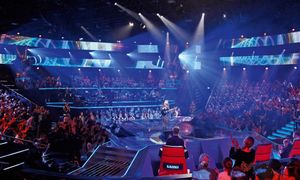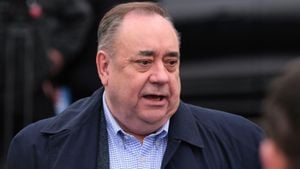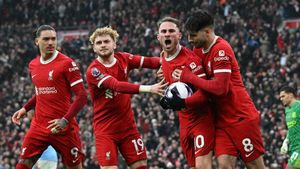With the clock ticking down to the anticipated return of Donald Trump to the presidency, both Russia and Ukraine are at yet another pivotal moment in their conflict. The stakes are high, with each side focusing on gaining more ground—or maintaining their current positions—before possible negotiations are enforced.
Since the onset of the war, the scenario has evolved sharply, particularly as Trump himself has made bold claims about resolving the conflict within what he calls "24 hours" after regaining office. His intentions include appointing retired Lieutenant General Keith Kellogg as the special envoy for Ukraine and Russia, which indicates the seriousness of Trump's approach to the conflict. Kellogg's mandate is clear: negotiate truce possibilities to facilitate peace talks.
This prediction of imminent negotiations has fueled escalated actions on both sides. Recent reports highlight intensified military strategies aimed at tactical advantages. On the Ukrainian side, the military has focused on maintaining its defenses and seeking more sophisticated military support from allies, which is expected to bolster its long-term strategy.
Meanwhile, Russia seems equally eager to seize whatever opportunities it can before the political tides shift with Trump's inauguration slated for January 20. Intelligence sources indicate Russia's involvement of thousands of North Korean troops and their increasing reliance on modern weaponry, including new missile technologies, to achieve their objectives. This intensified military push stems from the notion of gaining as much ground as possible before any official peace process begins.
“Everyone is assuming there will be negotiations soon, hence both Russia and Ukraine are doing their utmost to secure advantageous positions,” said one Western official who requested anonymity to discuss sensitive matters. Insiders liken this current phase to the calm before the storm, wherein both nations ramp up efforts with the looming goal of influencing negotiations.
Ukrainian Foreign Minister Andrii Sybiha recently reached out to NATO, emphasizing the need for Ukraine to receive formal invitations for membership during the upcoming NATO Foreign Ministerial Meeting set for December 3-4. This move is seen as countering Russian President Vladimir Putin’s overarching strategy. Despite recognizing it’s impractical to join NATO amid the war, Sybiha argues early invitations would undermine Russia's narrative and strengthen Ukraine's international position.
“The invitation should not be perceived as escalation but rather as a step toward inevitability,” Sybiha conveyed. He views NATO membership as integral to any post-conflict stability and feels the timing could prove advantageous for Ukraine, especially with Trump promising changes to U.S. foreign policy.
NATO's consensus among its 32 members remains unsteady. Realistically, any decision involving Ukraine’s membership will require universal approval—a tough hurdle to clear amid differing opinions on the matter. But as debates within NATO ensue, the Ukrainian leadership presses this agenda, eager to showcase its resilience and unwavering belief in eventual membership.
The current military engagements reflect a high risk of miscalculation. Intelligence reports cite Moscow's loosening of restrictions on nuclear weapon usage, which raises concerns about potential escalations and highlights the inherent dangers of this turbulent phase.
The recent sweeping military strategies employed by Russia, described as "all-in" pushes, showcase Moscow's resolve to assert control even as they face significant resource costs. Reports indicate heavy losses among Russian troops as they attempt to reclaim and expand their occupied territories, raising questions about the sustainability of such aggressive tactics.
Political scientists observe the balance of power shifting, noting the potential for increased volatility as winter looms and supply chains become increasingly strained. With winter, the ability of both sides to sustain operations could alter dramatically, making this period even more decisive.
Reflecting on the potential peace talks, James Nixey from Chatham House asserts, "The next two months are pivotal, and just as both sides vie for territorial gains, they must tread carefully to avoid catastrophic misjudgments. A proposed strategy could reshape how negotiations proceed, particularly with Trump’s anticipated policy changes."
With international observers watching closely, the coming weeks could mark a significant turning point. Each tactical movement not only signals desperation or confidence but also shapes the narrative surrounding legitimacy and power within the region.
While Ukraine champions its struggle and resilience, bolstered by Western support, Russia's increasingly aggressive strategy spotlights the unpredictability entrenched within the conflict. The potential for resurgence or disengagement hinges on upcoming negotiations, but the path toward lasting peace remains riddled with complex power dynamics.
Optimism on either side is tempered by the knowing weight of history, rife with consequences of miscalculation and incomplete truces. The intertwined fates of both nations will undoubtedly dictate the realities of not just regional stability, but also global political and security landscapes.
With challenges mounting, the outcomes of potential diplomacy and military strategies will reverberate far beyond Ukraine’s borders, ensuring the actions of both sides are pivotal not only for immediate resolutions but also for shaping the future global order.
Whether Ukraine can join NATO under Trump’s regime or whether Russia will solidify its claims through military might will depend largely on these careful chess moves made within the next several heads of state. The potential consequences of these negotiations could redefine international relations and shape geopolitical landscapes for years to come.



